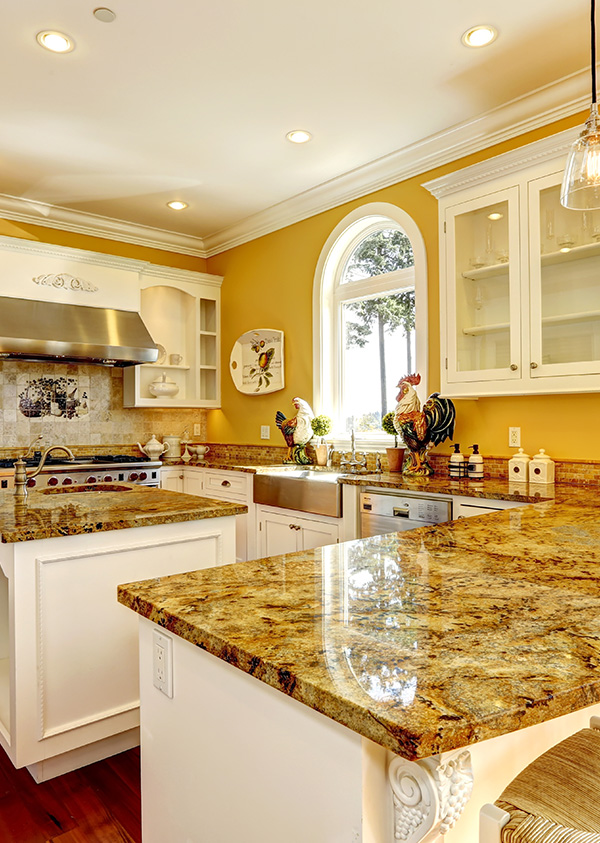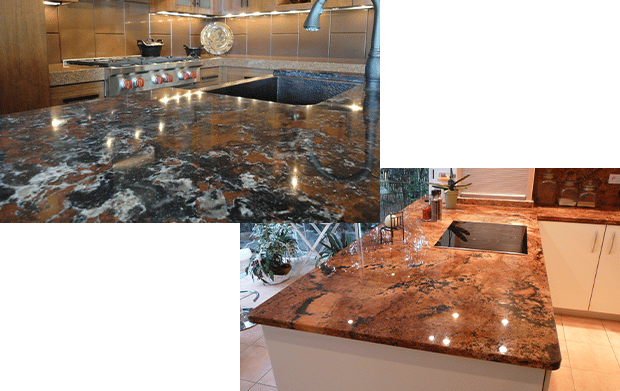With so many styles and materials, selecting the perfect countertops for your home isn't always easy. Your counters must be practical enough for everyday use and unique enough to complement your style. They hold a demanding role as the go-to area for food preparation and cleanup and are often front-and-center when snacks are needed for parties. The very best kitchen countertops in Mount Pleasant, SC mix beauty and style, setting your kitchen apart from your neighbors. But they must also be durable and useful, so you and your family can enjoy them for years to come.
At Everlasting Kitchen & Bath, we create countertops and kitchen cabinets that make a statement in your home where other features fall short. You've worked hard to foster an attractive appearance throughout the rest of your home, so why should your countertops be any different?
Here at Everlasting KB, we combine the durability and elegance of natural stone with personalized attention for each of our valued customers. Unlike other countertop fabricators, we source our materials from across the globe, searching high and low for the best stones available. In doing so, we are able to produce some of the finest remodeling and renovation products in our industry, from granite, marble, quartzite, quartz, and recycle glass countertops to new kitchen solid wood cabinets.
By providing high-quality materials and unmatched customer service, our clients have the chance to make informed decisions they feel great about. Our mission is to provide:

Impeccable Quality: You can count on Everlasting KB to design and craft your countertops and cabinets exactly as you imagined, with globally-sourced, high-quality materials.

Honesty & Integrity: Trust is a must when you invite someone into your home to discuss new kitchen renovations. We are privileged to serve you, and our technicians are dedicated to treating your home like it was our own.

True Craftsmanship: When we say personalized service, we mean it. Our artistry lies in getting the details of your project right, whether we're installing custom countertops or completely remodeling your kitchen.
As our testament to creating a better product for our clients, we use innovative technologies and the brightest minds in the business to create stunning countertops and cabinets. Because when it comes to your home, it needs to be as close to perfect as possible.
We offer a wide selection of stones and materials for your next kitchen renovation project:

Granite

Marble

Quartzite

Quartz
If you're in need of a professional, fast, reliable company for kitchen cabinets, countertops, and remodels, look no further than Everlasting Kitchen & Bath.

Our Most Popular Countertop Materials

When you're remodeling your kitchen or having new countertops installed, there are a lot of decisions to be made. From countertop material choices to counter placement preferences, each decision is impactful, making for an overwhelming experience. Luckily, at Everlasting Kitchen & Bath, we have a team of countertop experts who are more than happy to offer assistance and advice on your new countertop journey.
Most of our clients start by selecting the type of countertop material they want to use. If you're at this stage and aren't sure what to choose, ask yourself these questions:
- What countertop material looks best to you?
- What material best fits your lifestyle and home decor?
- Do you need an easy-to-clean surface, or does that not matter?
Still unsure? Swing by our showroom and let us help. Our kitchen remodeling experts can give you a rundown of the features and advantages of all our countertop materials, from durability to upkeep. Once you have those questions answered, you can begin narrowing down your selection. And what better way to do that than with a breakdown of our most popular countertop material choices?

Granite Countertops in Mount Pleasant, SC

Granite countertops are, without a doubt, the most popular choice for homeowners who want to install new kitchen countertops. Granite has held that position for years, and while it has competition, buyers love its luxurious looks and natural composition. Like some countertop materials, no two granite slabs will look exactly alike, giving your kitchen a unique aura.
Granite is a great choice for families, especially if you have children, as it has a hard surface that can withstand chips and scratches. Pricing on granite can vary depending on where it's sourced and how large the slab is. But one thing is for sure - if you're in need of a reliable countertop material for day-to-day use, granite should be atop your list.

Benefits of Granite Countertops in Mount Pleasant, SC
Affordable Choice
One of the biggest reasons granite countertops are so popular is because they can be quite affordable. That's especially important for families trying to stick to a kitchen remodeling budget. Prices of granite can vary, so be sure to speak with one of our expert associates at Everlasting KB for the most accurate pricing.
Resistance to Dings
Another popular reason to choose granite countertops over other materials is granite's resistance to scratches and chips. If you're like most folks, you'll be using your new countertops every day. Over time, counters can take a beating, especially when you have younger children. Fortunately, granite can withstand many scratches and chips, making it a popular choice for longevity and beauty. Remember, though - never use your granite countertops for dicing, cutting, or slicing. Use a cutting board instead, or you may damage your new countertops.
Resistance to Stains
When sealed properly, your granite countertops in Mount Pleasant, SC can resist stains. In fact, if a spill dries on your counters, you should be able to scrape them off gently with a plastic scraping tool. That's not to say that granite can't be stained at all - acids and alkaline can do a number on granite, so avoid spilling those substances on your counters. With that said, if you seal your granite counters every year and clean up spills quickly with soap and water, you should be able to avoid most long-lasting stains. At Everlasting KB, we are trained and certified for a permanent sealer with additional cost, that is warranty for 15 years. Don't forget to ask your sales representative for this permanent 15 years sealer as an option so you can be worry free.
Resistance to Heat
Like stains, granite countertops are also resistant to heat. Granite is formed in nature with heat and pressure, so it makes sense that it would have inherent heat-resistant properties. This is great news if you use your oven or toaster oven to cook dinner. If you accidentally place a hot pan on your granite counters, you don't have to worry. While we recommend placing oven-hot pans on potholders, you should be safe to use your granite counters too.
Uniqueness
Granite has many practical benefits over countertop materials, but it also has an aesthetic advantage. At Everlasting Kitchen & Bath, all our granite slabs are unique. If your neighbors have new granite countertops installed, you can rest easy knowing their granite won't be exactly like yours. If you're looking for a one-of-a-kind, cost-conscious option for your kitchen countertops, granite is a fantastic choice.
Other Popular Countertop Materials
Marble Countertops
Marble is a timeless material that exudes luxury. It has dynamic, detailed hues and is a very popular choice for homeowners in need of a high-end feel for their kitchen. Unlike granite counters, marble needs regular upkeep to maintain its beauty and durability.
Quartz Countertops
Like granite, quartz are engineering countertops are durable and don't require too much maintenance. It is non-porous and doesn't need to be sealed, so scratches and stains are minimal. However, unlike granite, you should avoid placing hot items on quartz countertops or you could risk damaging them. If you like marble with white and gray vein movements, quartz countertops is your best choice.

Flawless Kitchen Cabinets in Mount Pleasant, SC

No kitchen remodeling project would be complete without installing new cabinets. At Everlasting Kitchen & Bath, our experienced craftsmen have created and installed hundreds of new cabinets. We know that deciding on your new kitchen cabinets' material, finish, and style can be hard. That's why we're here to help every step of the way!
Our team has the tools, training, and experience to help you choose the best cabinets for your kitchen. We'll consider your current kitchen layout, your color preferences, and more to provide personalized options for your project. And when it's time to install your new cabinets, you can rest assured we'll get the job done right at a price you can afford.
Why Install New Kitchen Cabinets with Everlasting Kitchen & Bath?

When it comes to kitchen remodeling in Mount Pleasant, SC installing new kitchen cabinets is a great idea. If you're already upgrading or replacing your kitchen countertops, having new cabinets that match the aesthetics of your kitchen makeover is a no-brainer.
At Everlasting KB, we believe that everyone deserves an elegant, versatile kitchen with stunning cabinetry. That's why our team will work closely with you to discover the material, texture, and style of cabinets you're craving. Once we do, we handle all the heavy lifting, including cabinet design and installation in your home.
So, why should you install new kitchen cabinets alongside your countertops? Here are just a few reasons:

Matching Design
Many customers install new kitchen cabinets because they're already remodeling their kitchen and need their cabinets to match the aesthetics of their updated space. Do you want your kitchen to feel more open and airier? Do you have specific lifestyle requirements that necessitate a particular cabinet material? Our kitchen cabinet experts can help you find the perfect cabinet setup for your needs.

More Storage
Having a uniform aesthetic throughout your kitchen and home is important. But from a practical standpoint, new kitchen cabinets often mean more kitchen storage. That's a big deal for families, especially when younger children are involved. If you find that your countertops are magnets for clutter, new cabinetry can help remove the mess and stress less. The more storage your kitchen has, the easier it will be to use your kitchen for cooking and entertaining.

Boost Resale Value of Your Home
Take a few moments and check out the bones of your current cabinets. Low-quality, cheap cabinets are often a turnoff for potential buyers. If you plan on selling your home in the next few years, one of the best ways to boost resale value is with new cabinetry.

Enhanced Functionality
Is it a pain in the side to cook in your kitchen? Whether it's due to clutter, design, or something else, many of our customers want new cabinets so that their kitchen is functional again. New cabinets give you more storage, as mentioned above, but they can also make your kitchen more functional, depending on design and remodeling preferences. If you love to cook for your family and get-togethers, investing in new kitchen cabinets can help you do more of what you love.

Stunning First Impressions
Whether you're looking to "wow" a new client or work colleague or just want to make your neighbors a little jealous, upgrading your kitchen cabinets is a great way to do so. Of course, first impressions have always mattered, but particularly so in real estate. When the time comes to sell your home, having custom cabinets and countertops in your kitchen can set you apart from other sellers.
The Everlasting Difference

Here at Everlasting Kitchen & Bath, we specialize in custom kitchen countertops and cabinets designed especially for you. Whether you've been dreaming of traditional wood cabinets or need sleek, elegant granite countertops, we've got you covered. We are committed to affordable options while holding true to our craftsmanship and skills, providing customers with the best kitchen renovations in South Carolina.
If you're looking for the largest selection and the best prices, visit our showroom or contact us today. You've worked hard to make your home special, so why not your kitchen too? From design to installation, our team is here to help you every step of the way.
 843-764-3333
843-764-3333
Free Consultation
Disclaimer:



